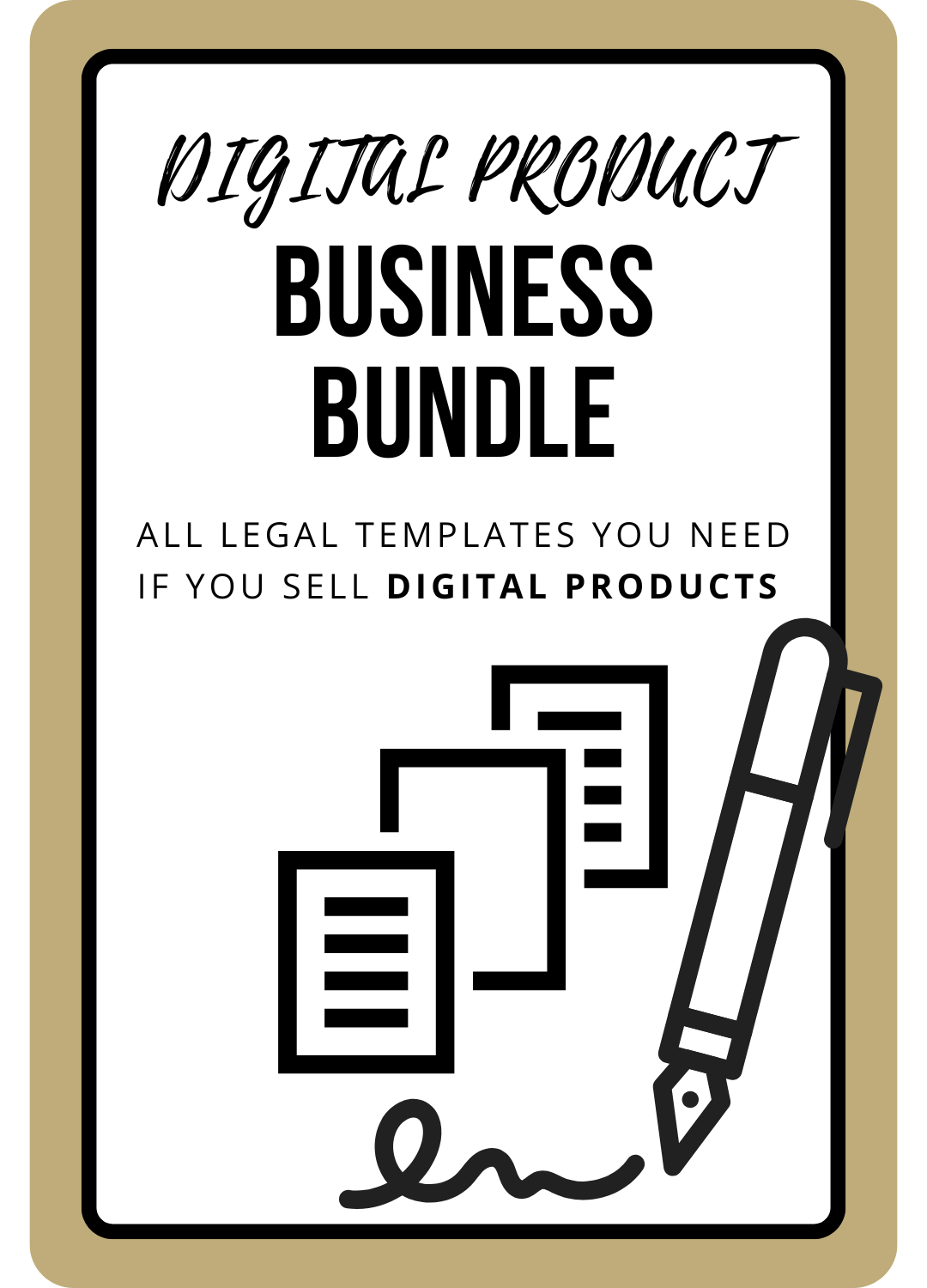10 Must-Haves for Terms and Conditions for Digital Products (Protect Your Content & Profits)
Wondering what you need in your terms and conditions for digital products? In short: everything that protects your content, your money, and your business from copycats, chargebacks, and customer disputes.
Selling digital products is exciting — it’s scalable, profitable, and a great way to earn income while you sleep. But as a lawyer who’s spent years drafting contracts for online entrepreneurs, I’ve also seen what happens when creators skip the fine print. From lost sales to stolen work, the risks are real (and preventable).
In this post, you’ll learn the 10 essential clauses every seller should have in their terms and conditions for digital products. We’ll cover everything from your digital product disclaimer to the refund policy for digital products to your privacy policy for digital products, so your content stays safe, your income secure, and your customers clear on the rules.
By the end, you’ll know exactly what to include so you can confidently sell your eBooks, templates, videos, designs, or any other digital products — without leaving legal gaps that could cost you money.
And if you’d rather skip the DIY drafting and get the exact legal wording ready to go? That’s why I created my Terms and Conditions for Digital Products Template — fully customizable to your products, your business, and your audience.
This post is all about the must-haves for your terms and conditions for digital products to protect your content, business, and money.
Ultimate Terms and Conditions for Digital Products
10 Must-Haves for the Best Terms and Conditions for Digital Products Example
Now, let’s get into what those 10 must-haves are to create the best terms and conditions for digital products example.
1. Access and Limitations
Your customers need to know exactly how and when they can access your digital products.
Your terms and conditions for digital products must specify:
Where they can access/download the product (link in your shop, email, third-party platform, etc.).
Time limits for download links — e.g., 7 days from purchase. Make it clear that if they don’t download in time, they lose access (you may choose to resend, but they’re not entitled to it).
Right to revoke access if they break your terms (e.g., request a chargeback, share your content without permission).
💡 What could go wrong?
A customer buys your $99 template, ignores the download email for 3 months, then demands a fresh link and threatens a PayPal dispute if you refuse. Without a clear time limit in your terms and conditions for digital products, you could be forced to deliver long after your intended terms.
✅ Want this clause done for you? My Terms and Conditions for Digital Products Template includes ready-to-use access & download wording.
2. Format & Compatibility
List the file formats you provide (e.g., PDF, DOCX, PNG, MP4) and the software/devices you recommend (Adobe Acrobat, Microsoft Word, VLC, etc.).
Add a compatibility disclaimer in your terms and conditions for digital products: Your products are designed for certain tools, but you’re not responsible for future software updates making them incompatible. That’s where this digital product disclaimer will save you.
💡 What could go wrong?
You sell an editable Canva template. A year later, Canva changes its interface, and a customer blames you for “breaking” the product. Without a compatibility disclaimer, you could be pressured into refunds for something outside your control.
✅ My template has a plug-and-play compatibility clause to save you from these headaches.
3. Disclaimers
That brings me to the next must-have for your terms and conditions for digital products: disclaimers. Protect yourself with a digital product disclaimer that covers:
No professional advice — content is informational only.
No client relationship — buying your product doesn’t give access to you personally.
Errors & omissions — you don’t guarantee 100% accuracy.
No warranties or guarantees — prevents unrealistic expectations.
Non-reliance — customers use info at their own risk.
Results disclaimer — you can’t promise outcomes.
💡 What could go wrong?
You sell a “30-Day Social Media Growth Plan.” A buyer follows part of it, doesn’t get 1,000 followers, and demands a refund because they didn’t achieve the result (they claim) your promised. Without a results disclaimer, you could face disputes or even legal claims.
✅ My template includes a full disclaimer section covering all of the above.
4. Usage (Not Ownership!) Rights
Customers buy a license to use, not ownership of, your digital products. Your terms and conditions for digital products spell out that:
They may use it for personal use only.
They may not claim ownership or distribute it.
💡 What could go wrong?
A customer buys your eBook, rebrands it with their logo, and sells it as their own. Without a clear license clause, it’s harder to stop them.
✅ My template has an airtight license & usage wording to stop copycats before they start.
5. Protect against Copycats & Oversharers
Go further than usage rights — explicitly forbid:
Resale, reproduction, or redistribution.
Sharing with friends, family, or third parties.
💡 What could go wrong?
You sell a $149 workbook. One customer shares it in a private Facebook group — suddenly, hundreds have it for free. Without an anti-sharing clause, you lose revenue and control over your content.
✅ My Terms and Conditions for Digital Products Template includes anti-sharing & anti-resale language.
6. Limiting Your Liability
Even if you do everything right, things can go wrong — and you don’t want to be financially responsible. Your terms and conditions for digital products must include:
Exclusion of liability for damages.
Cap on total liability (usually the amount paid).
💡 What could go wrong?
A customer downloads your $29 recipe guide, tries one recipe, and claims they got food poisoning. They threaten legal action for thousands. Without a liability clause, you’re exposed.
✅ My template includes legally sound liability limitations drafted for online entrepreneurs.
7. Payment Terms & Options
Be clear if you require full payment upfront or offer instalments. For payment plans, specify amounts, dates, and consequences for missed payments.
💡 What could go wrong?
You sell a $499 digital product with a 3-payment plan. The buyer downloads all content after the first payment and disappears. Without clear payment enforcement terms, you may never see the rest.
✅ My digital product policy has bulletproof payment terms for both upfront and instalment options.
8. No Refunds (Unless You Want to Offer Them)
Digital products can’t truly be “returned.” If you offer no refunds, say so clearly in your terms and conditions for digital products. If you do offer them, set strict conditions.
💡 What could go wrong?
A customer buys your digital art pack, uses it for a client project, then demands a refund claiming they “didn’t like it.” Without a no-refunds clause, you could be forced to repay for something they’ve already used.
✅ My template includes customizable refund & cancellation policies.
9. Compliance with Privacy Laws
If you collect customer info (name, email, payment details), you must comply with privacy laws. This means:
Linking to your privacy policy for digital products (and your website) in your terms.
Explaining how you collect, store, and use data.
💡 What could go wrong?
A customer in the EU asks about their stored data, and you can’t explain your process. This could trigger GDPR fines.
✅ My Terms and Conditions for Digital Products Template is built to align with privacy law requirements — and links seamlessly to your Privacy Policy.
📌 Also selling an online course or other digital offers?
Your terms and conditions for digital products are just the start. If you also sell online courses, the Digital Product Business Bundle gives you all the contracts you need in one go — so every product is protected and your income stays secure.
10. Updates & Future Access
From time to time, you may update your digital products.
Clearly state the following in your terms and conditions for digital products:
Clarify if updates are included or if your customers will need to purchase any new versions.
If your customers do receive access to updated versions, define whether customers get lifetime access or access for a limited time.
💡 What could go wrong?
You update your template with 20 new pages. Old customers demand the upgrade for free. Without clear terms, you may feel forced to deliver — eating into future sales.
✅ My template includes update & access clauses so your policies are crystal clear.
The ULTIMATE Terms and Conditions for Digital Products Template
You’ve just seen the 10 must-have clauses every seller should include in their terms and conditions for digital products. Without them, you risk:
Losing revenue to chargebacks or unauthorized sharing
Being held liable for customer complaints or unrealistic expectations
Spending time and money on disputes you could have prevented
Getting caught out by privacy law violations
Giving away free updates that cut into future sales
The easiest way to avoid all of this? Use a legally-sound, ready-to-customize template that covers every gap — without you having to spend hours writing one from scratch.
My Terms and Conditions for Digital Products Template Includes:
Iron-clad disclaimers to protect you from liability and false claims
Clear usage rights to stop copycats and oversharers
Payment & refund terms that keep your income secure
Privacy law compliance so you’re covered worldwide
Access, update & compatibility clauses that prevent disputes later
✅ Fully customizable — works for eBooks, templates, videos, courses, photos, and more
✅ Plug-and-play — just add your business details and you’re protected
✅ Written by a lawyer who specializes in contracts for online entrepreneurs
👉 Don’t wait until a customer dispute costs you sales, content, or your peace of mind.
Get your Terms and Conditions for Digital Products Template now and protect your business in minutes.
Want Every Contract You Need to Sell Digital Products and Courses?
The Digital Product Business Bundle includes:
Terms & Conditions for Digital Products Template (the one we just covered)
Terms & Conditions for Online Courses Template — protects your content, sets rules for students, prevents refund disputes
Legal Website Bundle — Privacy Policy, Website Terms, and Disclaimers to keep your site compliant and protect you legally
Why sellers love this bundle:
Save hours of DIY drafting — all contracts are ready to customize
Ensure every digital offer is covered by strong legal terms
Get everything in one purchase — no piecemeal shopping later
Written by a lawyer who specializes in contracts for digital entrepreneurs
One-time payment, lifetime access to your templates
👉 If you sell both digital products and online courses, don’t risk gaps in your protection.
Get the Digital Product Business Bundle here and safeguard your entire business in minutes.
This post was all about the essentials for your terms and conditions for digital products to protect your content, money, and business.
📚 Related Posts to Help You Protect Your Business:






